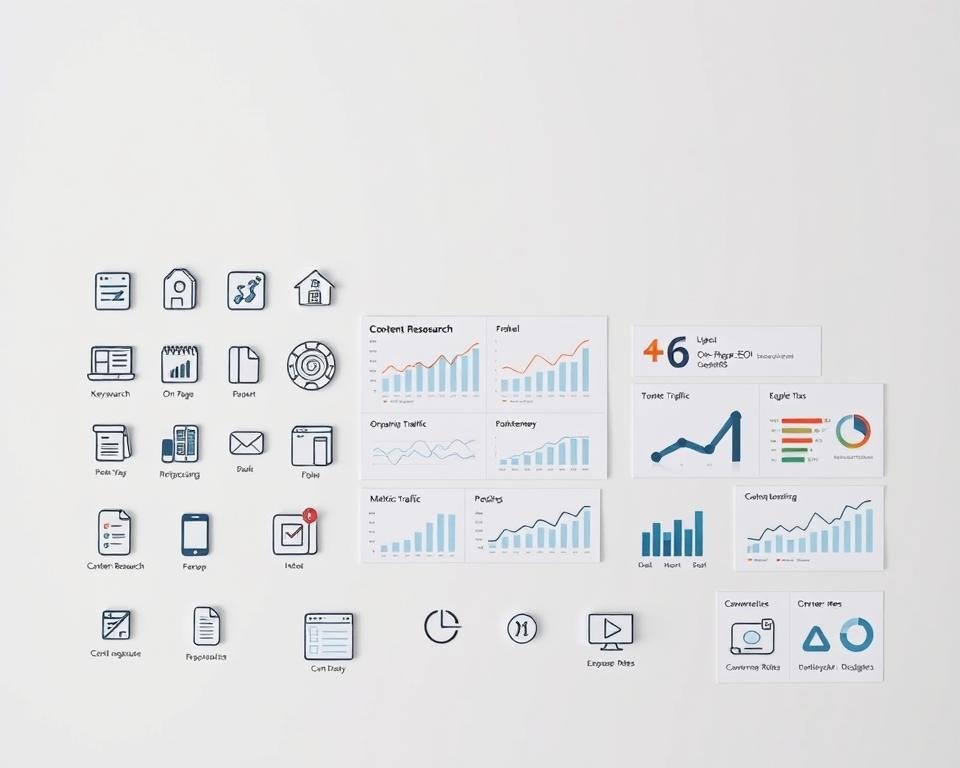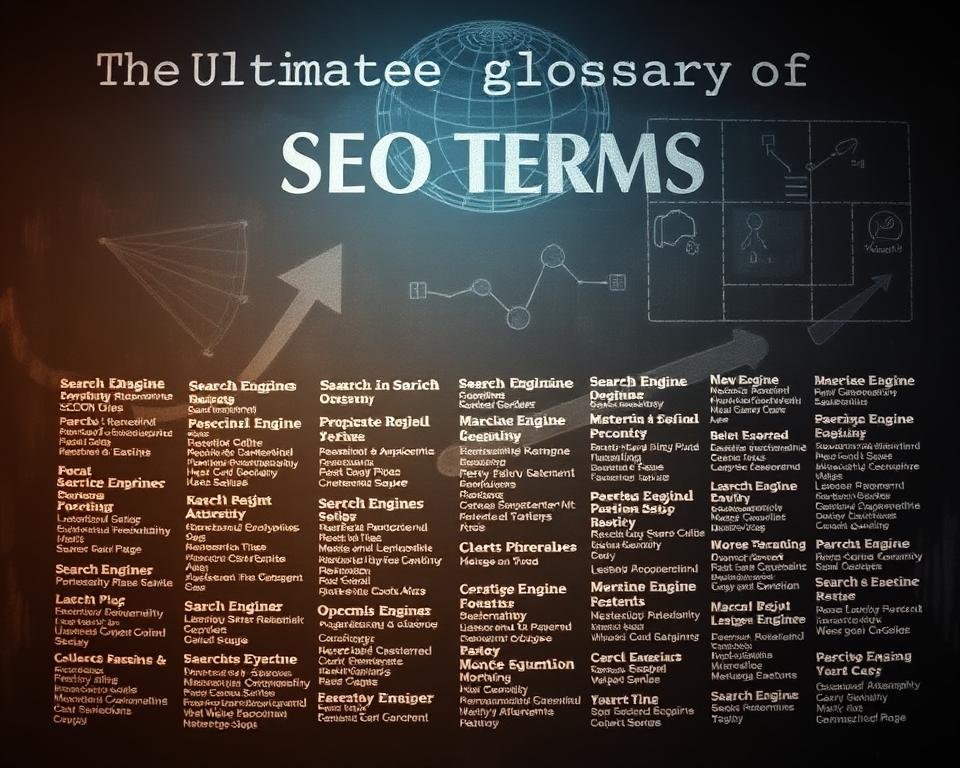Exploring Search Engine Optimization (SEO) shows me how vital it is to know the terms. SEO definitions are essential for moving through this complex field.
This guide will cover the top terms for online success. It’s great for both newbies and pros. Knowing the Search engine optimization glossary well keeps you ahead in digital marketing.
Key Takeaways
- Understand the basics of SEO definitions
- Familiarize yourself with key terms in the Search engine optimization glossary
- Learn how to apply SEO terminology in your online strategy
- Discover the importance of staying up-to-date with the latest SEO trends
- Improve your online presence with a solid grasp of SEO concepts
Understanding SEO Basics
Knowing SEO is key to a strong online presence. It’s important to understand the basics of Search Engine Optimization.
What is SEO?
SEO means Search Engine Optimization. It makes your website more visible in search results. You do this by making your site better for search engines.
Key aspects of SEO include:
- Keyword research and optimization
- On-page optimization (meta tags, titles, descriptions)
- Technical optimization (site speed, mobile responsiveness)
- Link building and off-page optimization
Importance of SEO
SEO is vital for anyone online. It boosts your site’s visibility and brings in more visitors. This can lead to more sales.
| Benefits of SEO | Description |
|---|---|
| Increased Visibility | Higher rankings in search engine results |
| Targeted Traffic | Attracting relevant audience to the website |
| Cost-Effective | Long-term results without ongoing advertising expenses |
Key SEO Facts
Understanding how search engines work is important. Knowing what they look for can help your site rank better.
- Search engines use algorithms to rank websites based on relevance and authority.
- The quality and quantity of backlinks significantly impact a website’s ranking.
- Mobile-friendliness and page speed are critical factors in search engine rankings.
Types of SEO Strategies
Knowing the different SEO strategies is key for a strong online presence. Each method has its own role in boosting a website’s ranking and visibility. A mix of these techniques is needed for the best results.
On-Page SEO
On-Page SEO makes your website friendly to search engines. It involves optimizing content, meta tags, titles, and descriptions. Good content is vital, as it tells search engines what your page is about.
Important On-Page SEO points include:
- Keyword research and optimization
- Meta tags and title optimization
- Content quality and relevance
- URL structure and internal linking
Off-Page SEO
Off-Page SEO boosts your website’s ranking through actions outside your site. It mainly focuses on link building. Getting links from other good websites shows search engines your site is reliable.
Key Off-Page SEO strategies are:
- Link building and outreach
- Social media presence and engagement
- Reviews and ratings
Technical SEO
Technical SEO deals with your website’s technical side. It ensures your site is technically sound and easy to use. This includes making your site fast, mobile-friendly, and easy for search engines to find.
Important Technical SEO elements are:
- Site speed optimization
- Mobile responsiveness
- XML sitemaps and robots.txt
- SSL encryption

| SEO Strategy | Description | Key Elements |
|---|---|---|
| On-Page SEO | Optimizing website elements | Content, Meta Tags, Titles |
| Off-Page SEO | Actions outside the website | Link Building, Social Media |
| Technical SEO | Technical optimization | Site Speed, Mobile Responsiveness |
Keyword Research Essentials
Keyword research is key in SEO. It helps find the words and phrases that bring the right visitors to your site. Knowing what people search for lets you make your content better, which helps your site rank higher.
Good keyword research is more than just picking popular words. It’s about finding the right mix of relevance, search volume, and competition. This mix is key to a successful SEO plan that speaks to your audience.
What are Keywords?
Keywords are the words and phrases people use when searching online. They connect what users are looking for with your website’s content.
Understanding keyword intent is crucial. It tells you why someone is searching for something. Are they looking to buy or just learn? Matching your content to their intent can boost your site’s relevance and ranking.
Tools for Keyword Research
Many tools can help with keyword research. Google Keyword Planner, Ahrefs, SEMrush, and Moz Keyword Explorer are popular ones. They give insights into search volume, competition, and related keywords, guiding your SEO choices.
These tools help find long-tail keywords. These are more specific and less crowded than general keywords. They bring more focused traffic to your site, which can lead to more conversions.

With the right tools and methods, you can craft a strong SEO plan. This plan will boost your online presence and attract more relevant visitors to your site.
Content Optimization Techniques
To make your website more visible, learning content optimization is key. It’s about making great content and tweaking it to rank better in search results.
Quality Content Creation
Making quality content is the base of a good SEO plan. It means creating content that’s both useful and fun to read. I aim to make content that meets my readers’ needs, making my site a go-to in my field.
Key parts of making great content include:
- Doing deep research for accurate info
- Writing clearly and simply
- Adding the right keywords to boost SEO
- Making sure the content is easy to follow

Importance of Meta Tags
Meta tags are vital for optimizing content. They give search engines key info about your pages. The two main ones are the title tag and the meta description.
The title tag shows up as your page’s title in search results. It should be short but tell what your page is about. A good title tag can really help more people click on your page. The meta description gives a quick peek at what your page is about. It should make people want to visit your site.
By tweaking these meta tags, I can get more people to see and visit my site.
Understanding Search Engines
Knowing how search engines work is key for a good SEO plan. They are complex systems that help us find what we need online.
How Search Engines Work
Search engines get data from huge databases. This data comes from a process called crawling. Crawling uses software (crawlers or spiders) to scan and index the web for new stuff.
After getting the data, search engines rank it. They look at things like how relevant and good the content is. This ranking decides how results are shown to us.
Indexing and Crawling
Indexing is when search engines sort crawled data into a big database. This database is used when we search for something.
Here are important things about indexing and crawling:
- Crawling Frequency: How often a site is crawled depends on its authority, how often it’s updated, and how relevant it is.
- Indexing Criteria: Not all crawled content gets indexed. It must be unique and of good quality.
- Link Equity: Links from trusted sites can help with crawling and indexing.
Knowing these steps can help make your website better for search engines. This can improve your site’s visibility and ranking.
Link Building Fundamentals
In the world of SEO, link building is key. It helps make your website more authoritative. Getting high-quality links from other sites boosts your site’s visibility and credibility.
What is Link Building?
Link building means getting links from other sites to yours. It’s important for your site’s ranking on search engines. The quality and number of links show how authoritative and relevant your site is.
I create valuable content that attracts links from other good sites. This helps my site’s SEO and gives my audience something useful.
Types of Links
There are mainly two link types: dofollow and nofollow. Knowing the difference is key for good link building.
- Dofollow Links: These links help your site’s authority and ranking. They tell search engines your content is valuable.
- Nofollow Links: These links don’t help your site’s ranking. They’re often for ads or user content. But, they can still bring visitors to your site.
Here’s a quick look at dofollow and nofollow links:
| Link Type | Link Equity | SEO Impact |
|---|---|---|
| Dofollow | Passed | High |
| Nofollow | Not Passed | Low |
To show what link building is, look at this image:

By using smart link building, you can boost your site’s SEO and online presence.
Local SEO Explained
In today’s digital world, local SEO is key for businesses. It helps them find their target audience. Knowing about local SEO can really boost your online presence.
Importance of Local SEO
Local SEO is vital for businesses focusing on specific areas. It makes your website more visible online. This can lead to more people visiting your store and higher sales.
Key benefits of local SEO include:
- Increased online visibility in local search results
- Targeted marketing to local customers
- Improved brand awareness within your community
- Enhanced credibility through local listings and citations
Local Listings and Citations
Local listings and citations are key for local SEO. A local listing is when your business is mentioned on online directories. A citation is when your business name, address, and phone number (NAP) are mentioned on other websites.
Best practices for local listings and citations:
- Ensure consistency in your NAP across all listings
- Claim and optimize your Google My Business listing
- Get listed in reputable local directories and citations
- Monitor and respond to customer reviews on your listings

Understanding local SEO and using local listings and citations wisely can boost your online presence. It also helps attract more local customers.
SEO Performance Measurement
Measuring your SEO performance is key to improving your online strategy. You need to know the important metrics that show success.
Key Performance Indicators (KPIs)
KPIs are numbers that show how well your SEO is doing. Important KPIs include:
- Organic traffic: The number of visitors from search engines.
- Keyword rankings: Your site’s spot in search results for certain keywords.
- Conversion rates: The percentage of visitors who do what you want them to.
| KPI | Description | Importance |
|---|---|---|
| Organic Traffic | Visitors from search engines | High |
| Keyword Rankings | Position in search results | High |
| Conversion Rates | Percentage of visitors completing a desired action | High |
Tools for SEO Analysis
Many tools can help you check your SEO performance. Some top picks are:
- Google Analytics: Gives insights into your site’s traffic and behavior.
- SEMrush: Does technical SEO audits, keyword research, and competitor analysis.
- Ahrefs: Helps with backlink analysis, keyword research, and content optimization.

Analyzing Organic Traffic
Looking at your organic traffic shows how people find your site. By studying traffic patterns, you can spot ways to boost your SEO.
Key things to check include:
- Traffic sources: See which search engines bring visitors to your site.
- Traffic volume: Watch how traffic changes over time to see if your SEO is working.
- User behavior: Study how users act on your site to find ways to improve.
Mobile SEO Optimization
Mobile devices are now the main way we use the internet. It’s key for websites to be mobile-friendly. This ensures a smooth experience for users.
Mobile optimization is no longer a choice but a necessity for any website aiming to improve its search engine rankings and drive more traffic. I will discuss the key aspects that make mobile SEO optimization so critical.
Importance of Mobile Optimization
Mobile optimization is vital because it directly impacts how users interact with your website. A mobile-friendly website ensures that visitors can easily navigate, read content, and engage with your site without facing difficulties such as zooming in and out or dealing with overlapping elements.
Search engines like Google prioritize mobile-friendly websites in their search results, making mobile optimization a key factor in achieving higher rankings. Moreover, a well-optimized mobile site can lead to improved conversion rates, as users are more likely to stay on a site that provides a good user experience.

Mobile-Friendly Design Principles
Creating a mobile-friendly design involves several key principles. First, it’s essential to use responsive web design that automatically adjusts the layout and content to fit different screen sizes and devices.
- Ensure that your website’s layout is flexible and adapts to various screen sizes.
- Optimize images and media to load quickly on mobile devices.
- Use clear and readable fonts, and ensure that the text is large enough to read without zooming.
- Simplify navigation to make it easy for users to find what they’re looking for.
- Test your website on different mobile devices to ensure compatibility.
By following these principles, you can create a mobile-friendly website. It will rank well in search engines and offer a great user experience.
SEO Trends and Developments
New trends and tech are changing SEO. It’s key to know how these changes affect our plans.
Voice Search Optimization is growing as more people use voice assistants. To get better at voice search, I use natural language and long-tail keywords.
Voice Search Optimization
Voice search changes how we do keyword research. It’s now about talking, not typing. This means we need to understand what users want better.
- Focus on conversational keywords
- Optimize for long-tail phrases
- Use structured data to enhance visibility
The Role of Artificial Intelligence
Artificial Intelligence (AI) is making SEO smarter. AI helps us analyze data better and automate tasks. It can predict what users will do and improve our rankings.
AI is great at handling big data fast and right. This helps us make better choices and more effective SEO strategies.
As AI gets better, it will play an even bigger part in SEO. This will open up new ways to optimize and grow.
Common SEO Mistakes to Avoid
SEO success means doing the right things and avoiding common mistakes. Knowing what to avoid is key to making your website more visible and ranked higher on search engines.
Two big mistakes are keyword stuffing and ignoring mobile users. Let’s look at these errors and how to steer clear of them.
Keyword Stuffing
Keyword stuffing is when you use too many keywords in your content. It makes your content hard to read and can get you flagged as spam by search engines.
To avoid this, create content that is engaging and naturally includes relevant keywords. Using different forms of your target keywords helps keep your content natural.
Best Practices to Avoid Keyword Stuffing:
- Use keywords in a natural and limited way.
- Choose long-tail keywords that are more specific and less competitive.
- Create content that is valuable to your audience.
Ignoring Mobile Users
Most people use mobile devices to access the internet. Ignoring mobile users can hurt your SEO. Search engines favor websites that work well on mobile.
A website that works well on mobile improves user experience and search rankings. Make sure your website is responsive and loads fast on mobile devices.
Key Considerations for Mobile Optimization:
| Feature | Importance | Best Practice |
|---|---|---|
| Responsive Design | High | Ensure your website adapts to different screen sizes. |
| Page Loading Speed | High | Optimize images and leverage browser caching. |
| Mobile-Friendly Content | Medium | Use concise headings and easily clickable elements. |
Avoiding SEO mistakes like keyword stuffing and ignoring mobile users can boost your website’s ranking. Keep up with the latest SEO trends and best practices to improve your strategy.
Resources for Continued Learning
To keep up with SEO trends, it’s key to keep learning. Look into valuable resources that can deepen your SEO knowledge. This will also boost your skills.
Recommended Blogs and Websites
Top blogs for SEO learning are Moz, Search Engine Journal, and Ahrefs. They offer a detailed SEO guide. You’ll learn about keyword research and link building.
They also have a big list of SEO terms. This helps you understand industry jargon.
SEO Courses and Certifications
For structured learning, check out SEO courses and certifications. HubSpot Academy, Coursera, and Google Analytics Academy offer these. They help you grasp SEO principles better.
These programs also keep you updated with the latest in the field.
